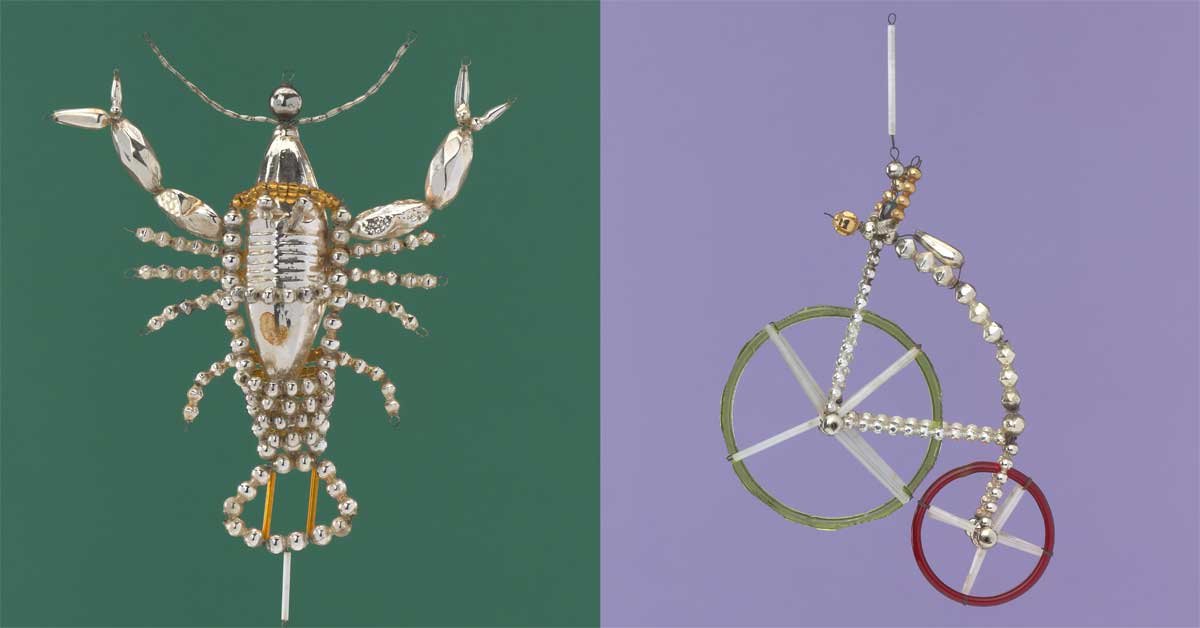

26 August 2025  Vienna's Museum of Applied Arts (MAK) will open its autumn season with the exhibition Bicycle & Lobster. Sparkling Tree Decorations from Gablonz (September 24, 2025 – February 1, 2026). More than 800 filigree ornaments, from miniature bicycles to lobsters, will be shown from the collection of art historian Waltraud Neuwirth. Their roots lie in the Bohemian glass and jewelry industry, which flourished during the Habsburg monarchy and established Gablonz an der Neiße (today Jablonec nad Nisou in the Czech Republic) as a center of innovation. From Jewelry Craft to Christmas TraditionThe glass beads and wire structures used for Gablonzer Christmas ornaments originated in the jewelry workshops of northern Bohemia. What began as a seasonal by-product of bijouterie soon developed into a distinctive art form, ranging from angels and stars to playful everyday motifs such as vehicles, animals, or musical instruments.The history of this ornament-making is closely tied to Austria. After the Second World War, the displacement of the Sudeten German population from Gablonz forced many artisans to resettle. In Austria and in Neugablonz, Germany, cooperatives were founded to continue the craft. This cultural and political history adds a further European dimension to the ornaments' story. It is not yet clear, however, how prominently this chapter of displacement and resettlement will be addressed in the MAK exhibition. Today, the delicate beadwork technique is still practiced in Poniklá, Czech Republic, and has been inscribed on the UNESCO list of Intangible Cultural Heritage. A Scholar's Lifelong PassionWaltraud Neuwirth is no stranger to the MAK. The Austrian art historian and curator once headed the museum's Glass and Ceramics Collection. She is the author of several books, maintains a dedicated website on the subject, and has assembled one of the most comprehensive private collections of Gablonzer ornaments, which she has donated to the museum. For the current show, she also acts as guest curator.Designing the Moment of UnpackingWhile Neuwirth provides the scholarly and historical framework, the exhibition's design is the work of Johanna Pichlbauer. The Austrian designer is also known for her installations that translate digital data into spatial form. She presented her experimental projects at Vienna Design Week, for example.For the MAK exhibition, Pichlbauer focuses on the ritual of unpacking—the moment when boxes are retrieved from attics or cellars, ornaments are rediscovered, and sparkling memories of former decades are combined in new arrangements. Her scenography captures both the intimacy of memory and the thrill of recombination: every decoration, whether a miniature bicycle or a glittering lobster, gains new life in a fresh constellation. From Collection to ShopAn exhibition at a design museum would not be complete without its tangible continuation in the shop. Alongside the scholarly catalogue Sparkling Tree Decorations from Gablonz 1920–1980, the MAK Design Shop will also offer a selection of original ornaments. Visitors thus have the opportunity not only to study this distinctive craft but also to carry a piece of it home.Images: Two examples of Gablonzer Christmas tree decorations from Jablonec nad Nisou: on the left, a lobster made of silvered glass beads and bugles mounted with wire; on the right, a miniature bicycle crafted from glass beads, bugles, and colored bangles. Both ornaments belong to the MAK collection. Photos: © MAK/Christian Mendez |